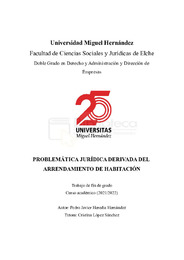Por favor, use este identificador para citar o enlazar este ítem:
https://hdl.handle.net/11000/28396Registro completo de metadatos
| Campo DC | Valor | Lengua/Idioma |
|---|---|---|
| dc.contributor.advisor | López Sánchez, Cristina | - |
| dc.contributor.author | Heredia Hernández, Pedro Javier | - |
| dc.contributor.other | Departamentos de la UMH::Ciencia Jurídica | es_ES |
| dc.date.accessioned | 2022-11-16T11:53:20Z | - |
| dc.date.available | 2022-11-16T11:53:20Z | - |
| dc.date.created | 2022-06 | - |
| dc.identifier.uri | https://hdl.handle.net/11000/28396 | - |
| dc.description.abstract | La realidad socioeconómica que viven muchas personas en nuestro país hoy en día ha desembocado en la creación de una figura de arrendamiento no concebida inicialmente por nuestro legislador: el contrato de arrendamiento por habitación (CAH). Debido a la necesidad permanente de vivienda que toda persona tiene, unida a problemas acaecidos como la subida del precio del alquiler, la falta de recursos y la necesidad de trabajar en ocasiones en zonas superpobladas han empujado a multitud de personas a optar por el CAH como solución a sus necesidades. Nuestra jurisprudencia ha analizado tal figura jurídica y ha ofrecido tres respuestas diferentes al análisis de su naturaleza y, sobre todo, de en qué norma ha de entenderse regulado. De esta manera, encontramos una corriente jurisprudencial que aboga por la utilización del art. 2 LAU, otra que confía en la necesidad de atenernos al art. 3 LAU y, por último, una tercera corriente que aboga por el uso del Código civil. Tras realizar la diferenciación entre cada una de ellas, se trata a su vez de diferenciar el CAH de figuras afines a priori como el subarrendamiento o el arrendamiento total de vivienda. A continuación se realiza un breve análisis del impacto del Covid-19 en la realidad inmobiliaria y en cómo afectó a diversas cláusulas como el caso de la cláusula rebus sic stantibus y a posibles finalizaciones anticipadas y unilaterales del contrato de arrendamiento. Por último, se presentan una serie de conclusiones con el objetivo de tratar de arrojar luz sobre este asunto tan difuso. | es_ES |
| dc.description.abstract | The socioeconomic reality that many people live in our country today has led to the creation of a type of lease not initially conceived by our legislator: the contract of lease for habitation (CAH). Due to the permanent need for housing that every person has, together with problems such as the increase in the price of rent, the lack of resources and the need to work sometimes in overpopulated areas have pushed many people to opt for the CAH as a solution to their needs. Our jurisprudence has analyzed this legal figure and has offered three different answers to the analysis of its nature and, above all, in which norm it is to be understood as regulated. Thus, we find a current of case law that advocates the use of art. 2 LAU, another that relies on the need to abide by art. 3 LAU and, finally, a third current that advocates the use of the Civil Code. After differentiating between each of them, we try to differentiate the CAH from a priori related concepts such as subleasing or the total lease of a dwelling. This is followed by a brief analysis of the impact of Covid-19 on the real estate reality and how it affected various clauses such as the rebus sic stantibus clause and possible early and unilateral termination of the lease. Finally, a series of conclusions are presented with the aim of trying to shed light on this diffuse matter. | es_ES |
| dc.format | application/pdf | es_ES |
| dc.format.extent | 46 | es_ES |
| dc.language.iso | spa | es_ES |
| dc.publisher | Universidad Miguel Hernández de Elche | es_ES |
| dc.rights | info:eu-repo/semantics/openAccess | es_ES |
| dc.rights | Attribution-NonCommercial-NoDerivatives 4.0 Internacional | * |
| dc.rights.uri | http://creativecommons.org/licenses/by-nc-nd/4.0/ | * |
| dc.subject | arrendamiento | es_ES |
| dc.subject | habitación | es_ES |
| dc.subject | habitabilidad | es_ES |
| dc.subject.other | CDU::3 - Ciencias sociales::34 - Derecho | es_ES |
| dc.title | Problemática jurídica derivada del arrendamiento de habitación | es_ES |
| dc.type | info:eu-repo/semantics/bachelorThesis | es_ES |

Ver/Abrir:
TFG DERECHO-Heredia Hernández, Pedro Javier.pdf
744,43 kB
Adobe PDF
Compartir:
 La licencia se describe como: Atribución-NonComercial-NoDerivada 4.0 Internacional.
La licencia se describe como: Atribución-NonComercial-NoDerivada 4.0 Internacional.
.png)